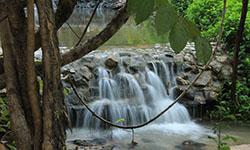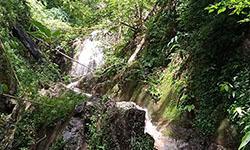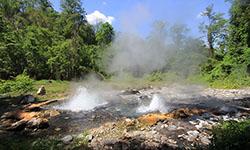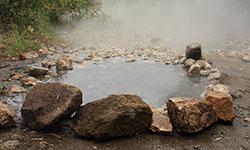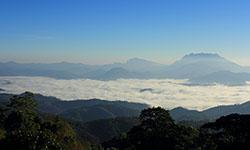Huai Nam Dang National Park
Contact Location : Huai Nam Dang National Park, Moo 5, Kuet Chang Sub-district, Mae Taeng District, Chiang Mai Province 50150
Telephone Number : (+66) 8 2187 7834 , (+66) 8 4908 1531 , (+66) 9 3632 1601
Email : namdangnp@hotmail.co.th
Facebook : Huai Nam Dang National Park
Information
Huai Nam Dang National Park encompasses the Mae Taeng, Wiang Haeng, Chiang Dao, Chiang Mai Province and Pai District in Mae Hong Son Province. It is forest region with tower karsts, which are part of a complex mountain landscape environment with an upstream forest. There are numerous natural features and vantage points from which to appreciate the shaded atmosphere, particularly in the vicinity of Nam Dang Creek, dubbed the most beautiful mountain mists in Thailand. Huai Nam Dang National Park, contains numerous other stunning mountain summits, including Doi Chang, Doi Sam Muen, and Pong Dueat, a natural hot spring. Rafting on the Mae Taeng Stream is also gaining popularity. It is 782,575 rai (1,252.12 square kilometers) in area.
Background
According to the Royal Forest Department Civil Service Subcommittee (OCSC) resolution No. 9/2530 dated June 2, 1987, assigning the Watershed Conservation Divisionthe andthe National Park Division to conduct surveys’in Chiang Mai Province's Watershed Development Station No. 2 (Huai Nam Dang) to consider establishing a National Park according to the recommendation of the Watershed Conservation Divistion. The National Park Division issued a letter No. Ko So 0713 / dated December 3rd, 1987, assigning Mr. Narong Charoenchai, Forestry Officer Level4, to conduct an area survey with the head of the Watershed Development Station No.2 (Huai Nam Dang), the head of the Watershed Development Station No. 4 (Mae Chaem Luang) and Head of Watershed Development Station No. 9 (Huai Nam Ru). The result was attached to the letter No. Ko So 0713 (To Po) / 86, dated April 3rd, 1988. However, it was lack of details and the appropriate demarcation to define the National Park boundary. Moreover, Pong Dueat Forest Park in Chiang Mai Province issued a letter No. Ko So 0713 (Po Do)/10, dated February 29th, 1988, stating that the area adjacent to the park is suitable for incorporation into the Watershed Development Station No. 2 (Huai Nam Dang) and was established as a National Park.
The National Park Division issued a letter No. Ko So 0713/950 dated August 16th, 1988, to the Royal Forest Department, to assign Mr. Sawat Thawirat, Forestry Officer Level 4, Head of Pong Dueat Forest Park, to conduct a preliminary survey. The survey report attached to the letter No. Ko So 0713 (Po Do)/74, dated December 14th, 1988 stating that the survey was conducted together with Mr. Narong Charoenchai, Forestry Officer Level 4, and found out that the surveyed areas are completely covered with natural forest in complex mountain landscape and served as watershed forest. There are numerous stunning natural features that would be ideal for establishment as a National Park.
The National Parks Division issued the letter No. Ko So 0713/206 dated February 21st, 1989, asking the Royal Forest Department to approve the partial areas of Watershed Development Station No. 2 (Huai Nam Dang), Watershed Development Station No. 4 (Mae Chok Luang), Watershed Development Station No. 9 (Huai Nam Ru), and the area of Mae Pai Fang-Sai Ton Bon National Reserved Forest in Mae Taeng National Reserved Forest, Kuet Chang Sub-district, Mae Taeng District, Chiang Mai Province, and Mae Hi Sub-district, Pai District, Mae Hong Son Province, with an area of 1,252.12 square kilometers or 782,575 rai, as a National Park under the National Park Act 1961.
Later the Natonal Park Division sent a letter No. Ko So 0712/9, dated November 27th, 1991, to Huai Nam Dang National Park. Them to coordinate with the head of the Mae Lao-Mae Sae Non-Hunting Area to survey parts of the Mae Lao-Mae Sae Non-Hunting Area and Pong Dueat Forest Parkin the districts of Mueang Khon Sub-district, Chiang Dao District and Pa Pae, Mueang Kai Sub-district in Mae Taeng District, Chiang Mai Province. to a new National Park covering 118,906.25 rai or 190.25 square kilometers being established. Visitors had discovered that the majority of areas had fertile forest conditions and the area had tremendous potential. Pong Dueat, Waterfall, Mae Taeng Basin, and waterfalls are all beautiful, and it had an abundance of wildlife and the diversity of plants, it is incredibly appropriate to become a National Park.
Huai Nam Dang National Park was established by royal decree, encompassing the Chiang Dao Forest and Mae Taeng Forest’in Chiang Mai Province's Piang Luang and Mueang Haeng Sub-district, Wiang Haeng District, Kuet Chang and Pa Pae Sub-district, Mae Taeng District, Chiang Mai Province. Additionally, Mae Pai Fang-Sai Ton Bon Forest is located in Wiang Nuea and Mae Hie Sub-district, Pai District, Mae Hong Son Province on the upper left side which was published in Volume 112, Chapter 33 Ko of the Government Gazette with an area covers 782,575 rai or 1,252.12 square kilometers and it became ’the country's 81st National Park.
Note : After paying the entrance fee to the National Park, please carry the receipt for inspection.
782,575 rai (1,252.12 square kilometers)
|
|
|
|
|
|
|
|
|
Nature trails ⇔ Trekking ⇔ Visit Waterfall ⇔ Swimming ⇔ Observe flowers/plant ⇔ Bird , butterfly , wildlife watching activities ⇔ Stargazing ⇔ Take a photo/Video ⇔ Camping ⇔ Relax in a nature
Welfare shop : 08.30 - 18:00 hrs.
Mobile phone signal:
1. National Park Headquarters area: AIS, TRUE, DTAC
2. Mae Ngat Sombun Chon Dam area: AIS, TRUE, DTAC
3. The area in Mae Ngat Sombun Chon Dam: AIS
4. Doi Mon Lan Summit: AIS, TRUE, DTAC
5. Doi Mon Lan service center area: AIS, TRUE, DTAC
6. Area of the National Park Ranger Station No. So Lo 8, Doi Mon Lan: AIS
|
|
The terrain consists of mountainsand valleys with the range running north-south through Daen Lao, Thanon Thongchai Mountain range, and Phi Pan Nam Mountain range. The mountains were created by geothermal changes associated with magma pressure insertions. The east-west compression force bends the surface into mountains and mountains. Additionally, there are valleys formed by sagging faults, as well as erosion caused by physical and chemical prtheses. The accumulation of sediment has resulted in the formation of a narrow plain between the mountains on both sides of the river. The park is located at an elevation of 400 to 1,962 meters above sea level a’d is home to Thailand's highest summit, Doi Chang, as well as a forest that contains tributaries of major rivers such as the Mae Taeng and Pai rivers. It is Watershed class A to class 1A as a catchment area, with numerous small and large creeksflowing through the area, including Hia Creek, Mae Ya Creek, Hom Creek, Nam Dang Creek, Mae Sala Luang Creek, Pong Creek, Nam Ngum, Mae Phlaem Creek, Ngu Creek,Mae Yen Luang Creek, Noi Creek,Hom Creek. Hok Creek, Mae Hi Creek, Khan Creek, Mae Ping Creek, and Mae Chok Luang Creek |
|
The climate is generally mild throughout the year with temperatures averaging around 20 degrees Celsius. From October to February, the average lowest temperature is 8 degrees Celsius. Between March and April, the average minimum temperature is 23 degrees Celsius. Huai Nam Dang National Park is located in two provinces, Chiang Mai and Mae Hong Son The forest area is affected by both the southwest and northeast monsoons andcyclones. As a result, here are three main seasons: - The rainy season is from May to September and has a maximum temperature of approximately 24 degrees Celsius and minimum temperature of approximately 10 degrees Celsius. The average annual rainfall is 1,134 millimeters and the prevalent wind is from the southwest. - The winter season lasts from late October to February and has an average maximum temperature of approximately 20 degrees Celsius; the average minimum temperature is approximately 2 degrees Celsius and the prevalentwind is from the northeast. - Summer begins in March and lasts until April and is hotter, with an average maximum temperature of 28 degrees Celsius, while the average minimum temperature is approximately 12 degrees Celsius. The wind blowiหout of the southwest. |
|
|
|
Huai Nam Dang National Park is home to many natural environments, and a variety of ecosystems remain at different elevations. At a height of 500-800 meters above sea level, the tropical rain forest covers both sides of the river and includes Bischofia javanica, Linociera ramiflora, Jambolan Plum, Bombox anceps, Sterculia villosa, Indochinese Milla, Glochidion sphaerogynum, and Croton persimilis Mull among the most significant plants. Lower ground shrubs and plants including Indian Head Ginger, Dioscorea glabra, Asparagus racemosus, Pseuderanthemum graciliflorum, Equisetum debile, Bamboo Grass, Shower Orchid, Asiatic Bitter Yam, Desmos chinensis, Micromelum minutum, Osmunda Spp, Jackal Jujube, and many others. Hill evergreen forests are found in the canyons and on slopes with a year-round climate that is relatively warm and humid. They can even exist at an elevation of approximately 1,650–1,900 meters above sea level. The main types of wood include Quercus semiserrata, Quercus kingiana Craib, Benguet Pine, Syzygium antisepticum, Actinidiaceae, Chooerospondias axillaries, Acer laurinum, Macaranga gigantean Muell, Michelia rajaniana Craib, Manglietia garrettii Craib, Symplocos cochinchinensis, Ficus semicordata, Cymbopogon citratus, Anneslea fragrans Wall, Betula alnoides, and Litsea monopetala. Shrubs and plants of the lower ground include bananas, Polygala arillata, Vanilla siamensis, Persicaria chinensis, Carex baccans Nees, Bamboo Grass, Piper nigrum, Hemigraphis alternata, and the Ginger Flower. A mixed deciduous forest covers a large area of the park below 900 meters above sea level. There are numerous significant plant species including Vitex peduncularis, Lannea coromandelica, Markhamia stipulate, Xylia xylocarpa, Garuga pinnata, Burma Padauk, Diospyros mollis, Spondias pinnata, Calophyllum calaba, Tamalin, and Wrightia religiosa Benth. There are many, shrubs and plants on the lower ground, such as Harrisonia perforate, Oxyceros horridus, Pseuderanthemum graciliflorum, Caryota urens, Marsilea crenata Presl, Mucuna macrocarpa, Chromolaena odorata, Amorphophallus campanulatus, Lygodium flexuosum, Platyceri’m, Phyllodium longipes, Paddy's Lucerne, and Selaginella argentea Spring. Deciduous dipterocarp forests are found primarily below 800 meters above sea level. The principal wood species in them include Burma Sal, Hairy Keruing, Dipterocarpus tuberculatus, Burmese Sal, Terminalia alata Heyne, White-Meranti, Vitex pinnata, Cratoxylum formosum (Jack), Terminalia chebula, Great Elephant Apple, Phyllanthus fmblica, Morinda coreia, Strychnos nux-vomica, and Senna sophera. Shrubs and plants of the lower ground include Leea indica, Abelmoschus moschatus Medik., Tuberosus, Gardenia obtusifolia, Inula cappa, Craibiodendron Stellatum, Pavetta indica, and Mikania cordata. The abundance of forest habitats means that many wildlife species live in the park, including Wild Elephants, Wild Deer, Asiatic Black Bear, Indian Muntjac, Lesser Mouse-Deer, Serow, Wild Boar, Leopard, Viverricula Indica, Rhesus Macaque, Lar Gibbon, Mongoose, Malayan Porcupine, Red Junglefowl, Silver Pheasant, Green Pigeons, Myna, Black-Naped Oriole, Stripe-Throated Bulbul, Changeable Hawk-Eagle, Himalayan Newt, Siamese Large-headed Terrapin, Asian Leaf Turtle, Calotes Emma, Ground Lizard, Clouded Monitor Lizard, Reticulated Python, Golden Tree Snake, Cobra, Malayan Giant Frog, Bush Frog, Limnonectes bagoyoma and Stripe Spadefoot Frog. In creeks and streams, they found Goldfin Tinfoil Barb, Scaphiodonichthys, Stone-Lapping Fish, Greater Brook Carp, Hillstream Loach, Freshwater Batfish, Hemimyzon nanensis and the Dwarf Snakehead. |
How to get there by car :
From Mueang District Chiang Mai Province take Highway No. 107 to the Mae Malai Market intersection in Mae Taeng District. Turn left onto Highway No. 1095 to Mae Malai-Pai. Visitors can reach Huai Nam Dang National Park via the following routes.
At milestone No. 42 there is an intersection on the right, and a sign indicating the entrance to National Park Ranger Station No Do No. 1 (Pong Dueat) can be found approximately 6.5 kilometers from Pong Nam Ron Pong Dueat Hot Springs. This area features villas, camping areas, mineral baths, steam baths, restrooms, and restaurants.
At milestone No. 65-66 there is a road on the the right side where the guard booth at the entrance to Huai Nam Dang National Park Headquarters is. Visitors should reach the Doi Kio Lom viewpoint after traveling approximately 3 kilometers, and this area features villas, camping areas, restrooms, toilets, and restau–ants.
The main route runs between milestone No. 87 - 88 and terminates at Ban Mae Ping. Atthe crossroads where there is a sign indicating the National Park Ranger Station No Do No. 2 (Pong Nam Ron Tha Pai). This is approximately 3 kilometers from Tha Pai Hot Spring area that contains camping areas, restrooms, toilets, and a restaurant.
Visitors seeking information on other tourist attractions can do so at the Huai Nam Dang National Park Visitor Center or contact the National Parks centrally.
- Central National Park Ranger Station (Ueang Ngoen)
- National Park Ranger Station No Do No. 1 (Pong Dueat)
- National Park Ranger Station No Do No. 2 (Pong Ron)
- National Park Ranger Station No Do No. 3 (Huai Hia)
- National Park Ranger Station No Do No. 4 (Sop Kai)
- National Park Ranger Station No Do No. 5 (Namtok Mae Hat)
- National Park Ranger Station No Do No. 6 (Namtok Mae Lat)
- National Park Ranger Station No Do No. 7 (Sai Ngam)
- National Park Ranger Station No Do No. 8 (Doi Sam Muen)
- National Park Ranger Station No Do No. 9 (Huai Hok)
- National Park Ranger Station No Do No. 10 (Tan Chet Ton)
- Accommodation - Ban Nam Dang 103 (Mok Fa 1)
- Accommodation - Ban Nam Dang 104 (Mok Fa 2)
- Accommodation - Ban Nam Dang 105 (Mok Fa 3)
- Accommodation – Ban Nam Dang 301-306 (Pong Dueat 1 - 6)


